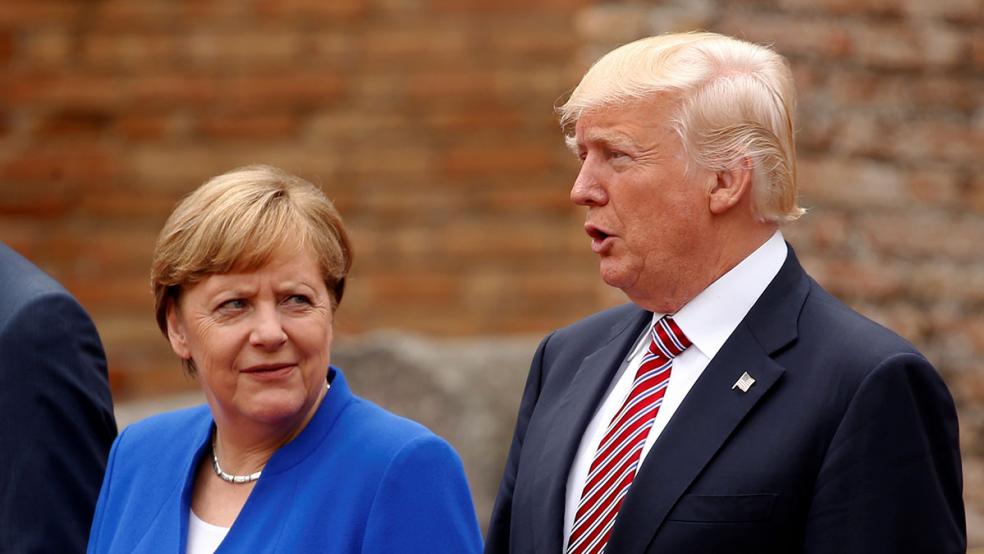President Trump is doubling down on his criticism of a key European ally.
Following a visit to Europe which left some longtime allies feeling discouraged about the reduced role the U.S. wants to play in their national security, the president rubbed some salt in the wound by attacking Germany, the United States’ largest trading partner in the European Union, on Tuesday morning.
Late last week, Trump reportedly excoriated Germany in a private meeting, saying the Germans are “very bad” on trade, particularly when it comes to automobiles, and promising to somehow put an end to the problem.
Related: 9 of the Oddest Moments from Trump’s First Foreign Trip
Trump’s spokespeople in the White House tried to tamp down the idea that the president had declared some sort of trade war with one of the country’s staunchest allies, but on Tuesday morning, the president blew their arguments out of the water with a single tweet.
We have a MASSIVE trade deficit with Germany, plus they pay FAR LESS than they should on NATO & military. Very bad for U.S. This will change
— Donald J. Trump (@realDonaldTrump) May 30, 2017
All this talk about fighting Germany on trade raises the question: Just how large is the U.S.-Germany trade gap, anyway?
When measuring U.S. trade volume, economists look at two broad categories: The largest is trade in goods, such as oil, lumber, automobiles and other tangible items. They also consider trade in services, which includes financial services, consulting, cloud-based software and other intangibles.
Related: Trump's 'Big Win' in Europe Is the World's Big Loss
Globally, the U.S. runs a very large trade deficit, about $500 billion in 2016, on a seasonally adjusted basis, according to the U.S. Bureau of Economic Analysis. That reflected the balance of a $750 billion deficit in goods-only trade, less a $249 billion surplus in the trade of services.
Over the ten-year period of 2007 to 2016, the U.S. ran a deficit in its goods-only trade with Germany in every one. On average, the U.S. imported $54.2 billion more from Germany that Germany imported from the U.S. But in any given year it fluctuated in very wide range. The deficit was $74.8 billion in 2015, but only $28.2 billion in 2009.
Add in the importation of services, and in 2016 the U.S. imported $67.8 billion more in goods and services from Germany than it exported. That’s the difference between the $80.4 billion worth of U.S. exports to Germany and the $148.1 billion in German imports to the U.S.
So, how does Germany stack up compared to the United States’ other trading partners? Well, there is no question that the trade imbalance with Germany accounts for a significant chunk of the U.S. trade deficit -- about 14 percent in 2016. While that puts Germany in the top five in terms of countries that enjoy a surplus in their trade with the U.S., some perspective is in order.
The trade deficit between the U.S. and Germany in 2016 was in the same neighborhood as deficits with other partners, like Mexico ($61.7 billion) and Japan ($56.3 billion).
Related: Does NATO Really Owe the US Money?
But none of those trading partners even comes close to the U.S. trade deficit with China which, at $310 billion, was larger than the deficits with all other countries combined.
So, even if the Trump administration were to somehow completely eliminate the U.S. trade deficit with Germany (which, to be clear, it can’t), it would mark a relatively small overall change in the total trade deficit.
However, even talking about the supposed need to eliminate the trade deficit with Germany effectively assumes that is a goal the U.S. ought to be pursuing. Trump, throughout his campaign and after his election, has described trade deficits as almost inherently evil. But trade economists take a far more nuanced view of the impact a trade deficit has on a country. Zimbabwe and Japan both run trade surpluses, for example, but neither is exactly a model of sustained economic growth.
Trump’s decision to target Germany in particular, is puzzling. The German government isn’t flooding the U.S. market with cheap goods that take advantage of lax labor standards and arguably cost American jobs. German workers are well-paid and unionized, and the goods they send to the U.S. are largely complex, big-ticket items like cars, appliances and medical equipment.
It’s odder still when it comes to cars. Germany exports a lot of cars to the U.S., it’s true. But German automakers also build an enormous number of cars in the United States. And one BMW plant in South Carolina accounts for about one of every five U.S.-built cars exported to other countries.
Related: Trump’s All Guns, No Butter Budget Is a Bust with Lawmakers
Like much of the president’s other rhetoric on trade and international relations, it may be fruitless to look for the through-line of his declarations in the realm of policy.
Why did he decide to lash out at Germany in a tweet Tuesday morning, even after the White House tried to insist that he wasn’t signaling aggressive action against Germany? Perhaps, as often seems to be the case, he was responding to what he sees as unfair criticism.
German Chancellor Angela Merkel over the weekend generated international headlines when she warned members of her party that she no longer views the United States as a reliable partner in global affairs. To Trump, those are fighting words, and perhaps the president saw harsh rhetoric on trade as the most convenient “counter-punch” he could deliver.





